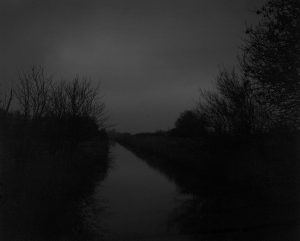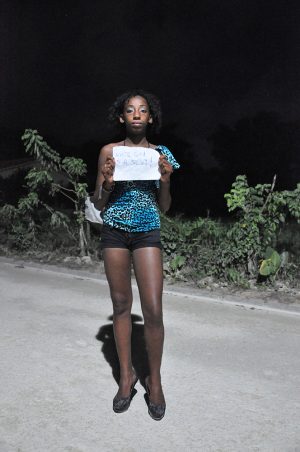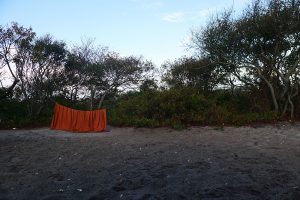At the turn of the 21st Century, the personal becomes political yet again. Society reclaims poetry and poetry opens up towards the surrounding world. In the Nordic countries, a new generation of female poets make their mark on the welfare state and a globalised, media-focused society. While body, gender, and identity are fundamental themes, ‘woman’ has become an increasingly contentious concept. Within the fields of post-structuralism, post/de-colonial critique, and queer theory there is a demand for feminism to be incorporated in the wider context of an expanding world view and there are claims that politics is very much embedded in language. In this respect, poetry has been amazingly adaptable and innovative.
This is the reason why the narrator in Mette Moestrup’s poem, kingsize (2006; kingsize, 2014), is able to conjugate love and exclaim, “I feel so grammatical tonight”. In Jeg æder mig selv som lyng. Pigesind (2012; I Eat Myself as Heather. A Girl’s Mind), Olga Ravn, Moestrup’s young friend and former student at the School of Creative Writing in Copenhagen, refers to the process of becoming a woman as “a grammatical discomfort” while an immigrant mother in Athena Farrokhzad’s Vitsvit (2010; White Blight, 2013) lets “the bleach run through the syntax”. In accordance with this inverted poetical epistemology, language governs experience rather than the other way round. Or, in the words of the narrative voice in Ingrid Storholmen’s Siriboka (2007; Siri’s Book): “It is from language that family comes”.

These new approaches to the deconstruction, reconstruction, and organisation of language and the new ways in which poets are able to appear in public have resulted in new ways for poetry to make an impact as a political tool. Maintaining previously inferred differences between politics and language has become less relevant. A number of Nordic female poets have given proof of the interdependence of form and content, regardless of whether the result is expressed through condensed short poems or wide-embracing, flowing prose poetry, and regardless of the chosen platform or medium. They open up for interaction and further reflection by means of an interactive and creative form of address.
Body and Construction
The increasingly conceptual nature of poetry began to manifest itself during the 1990s. The Swedish poet, Åsa-Maria Kraft (b. 1965), is among the leading poets in this respect. Body and construction merges in ingenious ways in several of her works. Her prose poetry collection, Ex Libris (1998), compares pregnancy and giving birth to writing, in the stanzas: Mitt kön sägs vara skapt/för detta, för skapelse (“My sex is said to be made/for this, for creation.”). In Diktaten (1999; Injunction) intercourse is associated with the construction of the Oeresund Bridge by means of linguistic leaps linking pornography and mechanics.
Through her linguistic experiments, Kraft has approached global politics even further. In Bevis (2005; Evidence), the Iraq War is described in the form of a tragedy of fate, in Permafrostens avtagande (2007; The Waning of Permafrost), the “Great Game” of climate change is described in the form of absurd drama, and in Randfenomen (2015; Peripheral Phenomena), a mediaeval saint’s legend is linked to contemporary mass deaths of bees. Kraft is a poet who seeks to describe the universal through the filter of personal experience. In Händerna lägger ner kransen. Svart Exlibris (2001; The Hands Lay Down the Wreath. Black Ex Libris) a miscarriage in the seventh week is the starting point of a requiem for an unborn son, a voyage between life and death, mythology and technology, the momentary and the eternal:
Du krymper tillbaka, har bitit dig fast
i landet du kom ifrån, min moderkaka
(You shrivel back inside, clinging/To the land you came from, my placenta)
The Genealogy of Girlhood
Contemporary poetry is intimately concerned with the living body, the body as situation, and as a vehicle for construction. Menstruation, sexuality, and pregnancy are narrated in the form of history, memory, and myth and in terms of personal and media-constructed contemporary experience. The focus here is on the body, on materiality, which is not eternal but constantly changing. The poem is concerned with the body itself while concurrently constructing a theory beyond it.

The acclaimed prose poetry debut of Olga Ravn (b. 1986), Jeg æder mig selv som lyng. Pigesind (2012; I Eat Myself Like Heather. A Girl’s Mind), offers sophisticated ideas on girlhood and on becoming a woman with the female breast being centre of attention for the sexualised narratives of society, science, and the media. With a particular rhythm and resonance, reminiscent of Edith Södergran, Gertrude Stein, and Inger Christensen and borrowing a subtitle from Tove Ditlevsen’s 1939 debut collection, Ravn experiments with positioning herself in a feminine, poetical tradition in which the discourse on language and gender theory of recent decades is intensely present:
[… ] fordi det træ ikke længere er træ, fordi rød er gennemtrængende, fordi teksten ikke er en afsluttet orden, fordi en velopdragen logiks sære lov, fordi kvinden ikke er en sø, fordi kvinden ikke er kvinden eller ikkekvinden og fordi manden ikke er, fordi overskridelsen af kønnet i teksten ikke er nok, fordi at tilbagevinde kroppen i teksten ikke er nok, fordi at kroppen findes.
([… ] because wood is no longer wood, because red is pervasive, because the text is not a finished/sequence, because of the strange laws of a well-mannered logic, because woman is not a lake, because woman is not the woman/or the not-woman and because man is not, because the transgression of gender in the text is not enough, because/regaining the body in the text is not enough, because the body exists.)
The Cosmology of Motherhood
A number of poets go beyond the human domain or relate it to post-humanist and eco-critical discourses. Through her particular use of language, Aase Berg (b. 1967), a poet and one of Sweden’s leading literary critics, blurs the boundaries and hierarchies between human and non-human, between myth and matter. Her first collections of poetry, Hos Rådjur (1997; With Deer, 2008), and Mörk materia (1999; Dark Matter, 2013), are characterized by a near-apocalyptic atmosphere where objects and order are created, destroyed, and reconstructed in mysterious processes, e.g. the poem “Moloss” from her debut: “Det jäser i substanserna, det fräter och bubblar i svalgen det dånar och det bryter samman bakom oss”. (The substances are fermenting, the throats are corroding and bubbling, there is roaring and destruction behind us.)

Berg’s acclaimed “Mother Trilogy” (2002–2007) encompasses the physiological processes of pregnancy and the psychological and existential dimensions of parenthood. In her condensed, short verse, the entire register of becoming a parent comes to the fore, from a sense of wonder and intensity of feeling to bottomless fear. The first volume, Forsla fett (2002; Transfer Fat, 2012), captures the sense of anticipation and the swelling of pregnancy in its routine magnificence:
Håll fett
låt fett vänta
håll tid
låt tid gå
låt tid vagga stilla i haren
låt fett bygga stomme i haren
i haren Kosmos
tid är skal
(Keep fat/let fat wait/keep time/let time go/let time rock calmly in hare/let fat build core in hare/in the hare Cosmos/time is shell. (Transl. Johannes Göransson))
While her next collection, Uppland (2005; Hinterland), describes parenthood as a bright and happy place – “nakenfisa, näcksmäck!/Frottofera mjölig tid”, (¬“nudefart, nudesmack!/clothograph mealy time”. (Transl. Johannes Göransson)) – Loss (2007; Loose) presents its dark opposite. Separation, loss, and inadequacy are portrayed against a backdrop of disasters and horrific events such as the 2004 Indian Ocean tsunami, the wars in Bosnia and Iraq, infanticide, and climate change.
Body and Thought
Contemporary poets have not been afraid of addressing the great subjects of love, evil, birth, and death. The Finnish poet Anni Sumari’s (b. 1965) philosophical poems alternate between brief, laconic statements and figurative reasoning shifting suddenly between reflection and declaration. In one of the cycles from her debut collection Mitta ja määrä (1998; Measurements and Quantities), the narrator questions the whole concept of reproduction; the oppressive identity of motherhood, the self-centredness of parenthood, the recurrent genocides:
I varje förlossning finns en övermänska begraven…
Kan man inte på något vis hejda dem som bär viljan att föda?
Jag känner nästan redan röken från köttugnarna, lukten av gas.
(A superhuman lies buried in every childbirth …/Is it not possible to somehow stop those who wish to give birth?/I can almost sense the smoke from the meat ovens, the smell of gas.)
In the long poem “Självbiografi” (Autobiography) from Vuodet vetten päällä (2003; Years on Water), the narrator offers a prosaic, yet grotesque, view of human existence and transience in the form of minced meat.
Body and thought are closely linked on the vital, contemporary young Danish poetry scene where poets such as Olga Ravn, Amalie Smith (b. 1985), and Asta Olivia Nordenhof (b. 1988), are engaged in various crossover projects of performances of the self. Smith, sometimes referred to as a hybrid artist, has since her debut, De næste 5000 dage (2010; The Next 5,000 Days), moved seamlessly between poetry, photography, popular science, and performance. On one level, I civil. Samling (2012; In Private. Collection) narrates a story of coming together in a loving relationship and separating due to illness, while on another level it offers theoretical reflections on togetherness and solitude, meeting and separating, memory and narration. The combination of poetry and prose, diary notes, lists, and photographs evoke a sense of authenticity while the work is concurrently toying with (auto)biographical codings.
Asta Olivia Nordenhof’s evocative, memory-based poems from her acclaimed debut, Det nemme og det ensomme (2013; The Practical and the Lonely), combine the narrators daily life in Copenhagen with memories of a difficult childhood marred by illness, death, grief, and violence. Personal experiences alternate with fragmentary aphorisms suggesting new directions, not least with regards to memory. Contrary to traditional historiography, physical memory is defined as the most enduring:
jeg vil komme med et råd
prøv at spør din hånd hvordan det er holde om noget du kender godt
sjippetorvets håndtag, en fedtet pik, hente salt og peber, nulre et blad, stryge en kat over ryggen, presse en bums eller rive en blomst op med rod: svub
det er så meget vigtigere end alt det nogen påstår man kan huske:
danskhed og alt det andet pis,
der er jo ingen der ægte kan huske en ridder
(I would like to offer a piece of advice/try and ask your hand what it’s like to hold something you know well/the handles of a skipping rope, a slippery cock, pick up salt and pepper, rub a leaf, stroke a cat across the back, squeeze a spot, or pull up a flower by its roots: swoosh/it’s so much more important than everything somebody claims you can remember:/Danishness and all that crap,/no one can, after all, really remember a knight.
The dissolution of Genre and Boundaries
Contemporary poetry is becoming increasingly aware of its position in a globalised media landscape, of being one of many voices. Value systems fall apart, anything from introspective poetry to advertising copy is included in poetic statements. There is a conviction that this ‘disorganized’ stance holds an intrinsic political potential and that the dissolution of boundaries contributes to the democratization of literary communication. The boundaries between producer and recipient have become less defined.
Mette Moestrup (b. 1969) belongs to an established generation of Danish poets who uphold and redefine the feminist story of body, gender, and identity with a spirit of authority, humour, and energy. Her frequently expansive collage poems, which are full of repetition and shifts in meaning, combine contemporary phenomena and myth in an associative, edgy flow. In one of the poems from Golden Delicious (2002), First World consumerism and exploitation are represented by a red grapefruit brought home from the supermarket:
Her i nord
kan vi kalde os for dem, som kalder grapen
for en eksotisk frugt
(Here in the North/we might refer to ourselves as the ones who call a grapefruit/an exotic fruit)
Moestrup’s puns combine high and low, evoking earlier poets such as Sappho, Emily Dickinson, Sylvia Plath, and Sonja Åkesson while placing contemporary Denmark under scrutiny; immigration policy, everyday racism, the colonial legacy, and prostitution. The comprehensive collection, kingsize (2006), reflects on the strange logic of Danish immigration policy, mathematically and linguistically:
Det er en etymologisk sammenhæng mellem love på dansk
og love på engelsk, som ligger til baggrund for 24-års reglen
(There is an etymological link between law in Danish/and love in English, on which the 24-year-statute is based)
In the extensive Dø, løgn, dø (2013; Die, Lie, Die), a conceptual analysis of the body and politics is expressed through the different shades of white paper set against the black cover. This tactile critique of whiteness permeates the entire collection:
Fjerlet hvidt
wc-papir vajer i vind
fra vinterstiv stang
i takt, takt, takt
til ung blond nationalsang
som hvidt flag.
(White toilet paper/light as a feather/is billowing in the wind/from a winter-stiff pole/in time, time, time/with a young blonde national anthem/like a white flag)
Critique of Whiteness in the Nordic Countries
The post- and de-colonial perspective has become increasingly visible in Nordic poetry in recent years. The long poem, Store hvide mand (Great White Man), from Icelandic poet, Kristín Eiríksdóttir’s (b. 1981) Annarskonar sæla (2008; Another Kind of Happiness) is an example of the way Western, white, patriarchal society has become the subject of a new form of critical, poetical analysis. In stanza upon stanza, the ‘great white man’ personifies a long capitalist tradition of abuse, colonialism, trafficking, sex tourism, and environmental destruction:
jeg ser igennem dig
elfenbenshvide strande
trommeslag
gemmer dig bag ved
jeepvindue dit gevær
glinser og dræber
dit rovdyr
eventyrlige hvide
mand
(I see through you/ivory white beaches/drum rolls/you are hiding behind/the jeep windscreen your gun/is shining and kills/your predator/adventurous white/man)
Several poetry collections exploring whiteness were published in 2012. Beside Moestrup’s Dø, løgn, dø, these include Christina Hagen’s (b. 1980) White Girl and Hanna Hallgren’s (b. 1972) Roslära (On Roses) (as well as Yahya Hassan’s (b. 1995) acclaimed YAHYA HASSAN). Athena Farrokhzad’s Vitsvit, published the following year, attracted much attention in Sweden. Despite their differences, these poetry collections share a strong focus on the relationship between language and identity, politics and skin colour.

In Hagen’s White Girl, a female Danish tourist uses postcards and letters to express her frustration with her treatment when holidaying abroad. The perspective is twisted by rendering her complaints in a kind of pidgin Danish, perkerdansk. The white woman is positioned as the Other, while the gaze is doubled, highlighting the prejudices of Western visitors as well as the cliché of Scandinavian sex maniacs prevalent at the various non-Western holiday destinations:
Du ikke tro White Girl har romantisk følelse? Du ikke tro, vi drømme om silkelagen og rød rose og den pæn ord?
(You not think White Girl has romantic feeling? You not think, we dream of silk sheet and red rose and pretty word?)
Farrokhzad’s Vitsvit is written from the painful space located between origin, departure, and adjustment. The narrator attempts to narrate the story of her family but is soon interrupted by family members who carry their own voices and versions of event: dreams about the revolution, memories of torture, and the scent of mint. In the background, a glimpse of a Sweden demanding assimilation rather than memories and experience. The very pages of the book express the contrasting identity and skin colour. The white letters of the stanzas race across a silent, black band.
Min mor lät blekmedlet rinna genom syntaxen
På andra sidan skiljetecknet blev hennes stavelse vitare
än en norrländsk vinter
(My mother ran bleach through the syntax/beyond the punctuation mark her syllables grew whiter /than winter in the very North of Sweden.)
Readers can scrutinize their own faces in the reflecting silver cover of the book.
Political Shifts of Perspective
Today’s poetry transcends the boundaries between academia, activism, and poetry. One prominent voice is the poet, critic, and gender studies scholar, Hanna Hallgren (b. 1972) who opens up new channels of communication between literature and the surrounding world through her distortion of words and concepts. In Burqa. Dikter (2003; Burqa. Poems), the enveloping outer garment associated with the Afghan Taliban regime constitutes a space for the discussion of oppression and liberation and serves as a linguistic strategy revealing the construction of difference and identity:
burqa “du som är jag”
ilande läppar “vi som är ni”
vårt som är ert
hjärta participt
(burqa “you who are me”/hurrying lips “we who are you”/ours that is yours/heart participle)
Roslära (2012; On Roses) constitutes a poetic positioning within the current post-colonial discourse and is a standpoint against all that is Swedish in this world: Slavery in the former colonies, the violations committed within the Swedish welfare system, xenophobia, denial, complacency, and violence – “a white method”. An associative word game which, among other things, explores the alliterative rose–race (ros–ras) duality, is informed by a complex critique on whiteness and nations:
Vit, i det lätta arbetets ljus
Röd, för allt blod som runnit för mig, att de vita stenhusens torg ännu står
Att min nation hör samman med slakt
– och grammatiskt blekmedel (diplomati, debatt) – – – att det är dagar, år,
ett hem vi har opererat, all omsorg om vårt folk.
(White, in the glow of light work/Red, for the blood that has been spilt for me, so the square with the white stone houses still stands /That my nation is associated with slaughter/– and grammatical bleach (diplomacy, debate) – – – because there are days, years, /a home we have operated on, all the care for our people.
Since the publication of her prize-winning debut collection, Sond (2005; Probe), Ida Börjel’s (b. 1975) conceptual, decoding method has been concerned with a critique of civilization. Skåneradio (2006; Scania Radio) listens in on everyday politics through the white noise of local radio stations broadcasting in southern Sweden. Konsumentköplagen: juris lyrik (2008; The Consumer Purchase Act, Legal Poetry) stages a poetical conversation between buyer and seller that develops into a critical yet comical investigation of power, capital, and legalese. A new tone of voice is apparent in the poem Ma (2014), an expansive A–Z of grief, where the monotone listing of all the cruelty in the world can only truly be understood when confronted with personal loss, void, and speechlessness:
nej det går inte att skriva
det kan inte skrivas
jag kan inte
jag kan inte
det ska inte gå att skriva
hur kan jag vara där dikten är
döden
döden vill jag vara
om du är
död
(no writing is not possible/it cannot be written/I cannot/I cannot/it should not be possible to write/how can I be where poetry is/death/death is what I want to be/if you are/dead)
Polyphony, Memory, and Myth

The artistically exploratory method and the polyphony of contemporary poetry is also evident in the work of the Norwegian poet and performance artist, Ingrid Storholmen (b. 1976) whose poetry is typographically challenging thanks to her playing with type, font size, and undulating lines. Skamtalen Graceland (2005; Disgrace Speech Graceland) investigates the recurring conflict between reproduction and creativity, love and humiliation. A woman raises her voice in an effort to navigate beyond the male rhetoric and gaze: “Bak setningen kan ingen se puppene mine.” (No one can see my breasts behind the sentence).
The personal, biographical legacy – family, roots, the history of women – is the starting point in Siriboka (2007; Siri’s Book), which, based on the life of one of Storholmen’s own ancestors, Siri Olsdattter, discusses the unattainable and inescapable legacy of past generations:
Jeg skal tvinges til å se på mitt liv som et arvestoff
med blodsbånd å kante bunaden med
(I will be forced to look upon my life as a legacy/blood ties for my national dress)
Like Plato’s dialogues, Til kjærlighetens pris (2011; In Praise of Love) weaves together different voices talking about love. Modernist love poetry addressed to a beloved “you” is juxtaposed with a dialogue between travellers in the borderland between Greece and Bulgaria, the setting of the classical myth of Orpheus and Eurydice. Both narratives use the original myth in order to reflect on creation and love – can they ever be joined?
Calvadosen er kald. Jeg spiser epler til så den ikke er alene i magen
Trekker tilbake alt jeg sa. Redd for at jeg ikke skal tørre å flykte
At hverdagen er der jeg trenger deg
Får jeg ennå kalle deg Orfeus?
– Hvordan hvor er han når han gjør det
– Ett eller annet sted langt inne i sangen
– Inne i sangen utenfor hulen før hulen etter hulen
– Ett eller annet sted i åpningen
jeg tenker at alt foregår i åpningen av hulen.
(The Calvados is chilled. I eat apples along with it so I don’t have an empty stomach/Take back everything I said. Afraid I won’t dare escape/Weekdays are when I long for you/May I still call you Orpheus?
– What’s he like when he does it/– Some place deep in the song/–In the song outside the cave before the cave after the cave/– Some place by the entrance/I’m thinking everything occurs by the entrance to the cave.)
Myth is also the underlying structure of the Icelandic poet Gerður Kristný’s (b. 1970) striking poems in Blóðhófnir (2010; Bloodhoof, 2012), a combination of the ancient Norse Poetic Edda and feminist “talking back” poetry. The poet’s namesake, Gerður the Giant, offers her own version of the story in Skírnismál where the Norse god, Freyr, falls in love with Gerður and sends his servant Skírnir to Jotunheim to ask for her hand in marriage. In Kristný’s version, Gerður gives in to Freyr too, but only as a result of threats and curses. She is forced to abandon her family and country in order to join the abusive Freyr.
Ensam låg jag
i ulvens gryt
med bitmärken
på bröstet
(I lay alone /in the wolf’s lair/with bite marks/on my chest)
Gerður gives birth to a son and the poem ends as she sits by the water, awaiting the arrival of the giants that will avenge the gods who abducted her. She can only hope that her son will be spared:
Jag inväntar
undergången
Frändfolk ska tränga
fram över bron
gå i krig
för kvinnorovs skull
(I await/destruction/Kinfolk will push/across the bridge/go to war/for the abduction of woman)
The short alliterated stanzas brutally describe the vulnerability of women and children in patriarchal cultures of honour, then and now.
The characters and metre typical of ancient Norse poetry are also present in the equally violent and tightly controlled Drápa (2014; Killing (Drápa is also an old Norse metre)), in which the poet adds elements from ancient Christian and Pagan traditions in order to describe the fear and brutality, which suddenly befalls present-day Reykjavík on a winter’s night. Kristný’s poetry is a testament to the dynamism and poetic tension, which may occur due to familiarity with myths and literary tradition.
Late Modernist Puns
While contemporary poetry is often urban, international, and expansive, there is also room for minimalist, restrained poems that communicate loneliness, isolation, and regionalism. In her increasingly brief, pared down poetry, the Finnish-Swedish poet, Heidi von Wright (b. 1980), charts and delineates human existence, a space somewhere between language and reality. With a crisp view of everyday life, from furniture to the weather forecast, in her debut collection skör och spräcklig (2003; frail and flecked), von Wright measures human relations to the same degree of precision as the charting of geographical, temporal, or linguistic distances:
den andras bana är en ellips med dig i ena brännpunkten.
rörelsen längs den andras bana sker intensivt.
den andra och du är konstant.
(the other’s orbit is an ellipse with you at one focal point./the movement along the orbit of the other is intense./the other and you are constant.)
In Delta (2012; Participate/Delta), the narrator’s voice observes relationships between people without yet taking part: “people. people. around the world./we are yet to meet”. The late modern dilemma of combining community and commitment with individualism and self-realization is constantly present.
vill vara
delaktig
ändå lämna mig ifred
(want to/participate/yet leave me alone)
When, after all, the possibility of two people living as a couple is suggested, there is a sense of irony reminiscent of Sonja Åkesson or Märta Tikkanen:
passar det att komma förbi i morgon
sätta upp balkonglådor
plantera kommande egendom
allt på mina villkor
(does it suit you to drop by tomorrow/to put up window boxes/plant future property/all on my terms)
The imagery of place and daily life forms a strong baseline in the poetry of Rebecca Kielland (b. 1983). Her unusually musical touch has been prominent since the debut collection Akkorda under fluktlinja (2007; Chords Below the Flight Line). Her next collection, Leve gammaldansen! (2011; Long Live Old-Time Dancing!), was quite a coup on the Norwegian poetry scene with its upbeat play on popular culture, folksiness, and clichés about small-town Norway. Or, in the words of one reviewer: “Kielland goes Prøysen (Norwegian poet and children’s author, transl.) goes bananas”.
In the more subdued Ute av skog (2013; Out of the Woods), a young woman leaves behind town and human interaction in order to write and heal her wounded spirit in the calm and solitude of the forest. The poems register her spending time on various everyday pursuits, small episodes that often end with a twist:
Jag kører over skogen.
“Ja, vi elsker” spilles på P1.
Jag tenker på “Ein idiot på tur”. Karl Pilkington ville klagd over at
alt ser likt ut, at det er mørke grantrær overalt. I like the song,
though, ville han sagt.
Hjemme leser jeg Allers på terrassen og dricker Prosecco.
“Det beste i livet er gratis” av Vazelina Bilopphøggers står på i bakgrunnen.
Jeg leser at sekstiseks prosent av norska menn ser seg selv som
grillsjefer. Kvinnene tar ansvar for tillbehøret.
(I drive through the forest/The national anthem is playing on the radio/I think of “An Idiot Abroad”. Karl Pilkington would have complained that/everything looks the same, that there are dark spruces everywhere. I like the song/though, is what he would have said./At home I’m reading Allers magazine on the terrace while drinking Prosecco/“The Best Things in Life are Free” with Vazelina Bilopphøggers is playing in the background/I read that sixty-six per cent of all Norwegian men consider themselves to be/masters of the barbecue. The women take care of the side dishes.)
The Meaning of Place
Place and identity are prominent features of a new generation of female poets from the Faroe Islands spearheaded by Sissal Kampmann (b. 1974) and Marjun Syderbø Kjelnæs (b. 1974). While they no longer reside in the Faeroe Islands, or perhaps for that very reason, the two poets process their Faeroese identity as simultaneous presence and absence. “Svävande på en plats emellan att vara/och att inte vara” (Suspended in a place between being/and not being), as Kampmann writes in her debut collection Ravnar á ljóðleysum (2012; Ravens with the Sound Off).
In Kampmann’s poetry, a sense of home is contrasted with rootlessness. The narrator tries to define focal points in the materiality of her new home: the stairs, the front door – “the one with my name on it” – her possessions. There is a lingering, yet unsettled, sense of grief:
I dag gråter jag för något annat
än jag gjorde för ett år sedan
I dag saknar jag på ett annat sätt
än jag gjorde för tre månader sedan
(Today, I cry for something other/than I did a year ago/Today, I sense the loss differently/than I did three months ago)

The contradictory recipe for survival in exile is also discernible in Kjelnæs’s poetry, e.g. the poem “Uppvaknande” (Awakening) included in her debut collection Rót Tripp – orð en route (2012; Root Trip. Words En Route):
Att gräva upp rötter
Inte slita loss dem
Att blottlägga dem
Men inte skära av dem
Att beskåda deras bleka farleder
I mörka mullen
(To dig up roots/Not tear them out/Exposing them/But not cutting them off/Observing their pale threads/In the dark soil)
Place and the journey from one place to another are also central to the work of Sigurbjörg Þrastardóttir (b. 1973). Her breakthrough, Hnattflug (2000; Round the World Trip), is a poetic tour around the world in the form of short reflections associated with various destinations. Her acclaimed fourth collection, Blysfarir (2007; Torch Procession), is a powerful 150-page cycle of poems about a destructive love affair between a young woman and a drug addict, written in one long, unbroken flow from the woman’s point of view. A story of dependence, drugs, and affirmation, about self-delusion and slow awakenings, it alternates between two locations, an island and a city, Iceland and Berlin. In this fairy tale, the princess is the one who must fight “the white dragon”.
Poetry in a Changing Media Landscape
Poetry has increasingly become the site for social critique, the quest for knowledge, and the disintegration of form, domains previously claimed by the novel.
Performance, poetry slam, poetry festivals, poetry film, blogs, and podcasts are examples of how poetry lives off the page. Today’s poets are multi-tasking, genre-bending artists who open the definitions of origin to interpretation, who toy with different personas, whilst they collaborate amongst themselves.
A striking example of one such collaborative practice is the genre-bending, 600-page Frit flet. Fællesbogen (2014; Loosely Woven. The Common Book) by Mette Moestrup, Naja Marie Aidt (b. 1963), and Line Knutzon, (b. 1965), in which the authors’ lives – teenage diaries, private photos, interviews with family members, and notes concerning the conditions of writing – are juxtaposed with the burning issues of contemporary life, e.g. the distribution of wealth, feminism, and migration. The cover mimics a glossy fashion magazine while the contents are an array of stories about freedom, gender, politics, and writing set in a plethora of typographies inspired by the collage aesthetics of the 1970s and informed by the rallying cry of the era: the personal is political.
Contemporary poetry is, in other words, brimming with dialogues across time, generations, nations, and media; it is full of translations, loans, intertext, and remediation.
There is an obvious desire to uphold and invigorate tradition, e.g. when Ida Börjel in Ma picks up Inger Christensen’s (1935–2009) classic structural poem, Alfabet (1981; Alphabet). By a simple changing of the verb tense – from the present tense of the now and the will to live to the past tense of history, grief, and loss – she transposes the pitch of the text downwards. This dislocation encompasses a different spirit of the times and an altered view of the possible accomplishments of language and poetry.
Here is the letter C in Christensen’s version and then in Börjel’s:
cikaderne findes; cikorie, chrom
og citrontræer findes; cikaderne findes;
cikaderne, ceder, cypres, cerebellum
(from: Alfabet, 1981)
(cicadas exist; chicory exist, chrome/and lemon trees exist/cicadas, cedar, cypress, cerebellum)
cementgrunden fanns, cellerna
grundluften fanns, cirkelbeviset
underrättelsetjänsten, de och de sina
gå i arv, undan
cykler; cyklernas oheliga allianser
cyborg; cementplatå; de och dem emellan
anstalterna, denimfabriken, begäret
hos de unga efter västerländska jeans
i DDR; vandringscellerna; varuflödet
kring de partitrogna
på metrostationerna vid Friedrichstrasse
flöde irrande i motflöde; ett
fotbollslags tröjreklam
för libyeningenjörens gröna bok
det fanns också: cybernetiken
crackpundaren, cystan
cyberrymdens
sårbarhet Syntagma
(from: Ma, 2014)
(concrete foundation existed, cells/foundation air existed, circular reasoning/the secret service, they and their likes/are inherited, away from the/cycles; the unholy alliances of cycles/cyborg; concrete plateau; between them/the prisons, denim factories, the desire/among the young for Western jeans/in the GDR; the wandering cells; the flow of goods /among the party loyalists at the Friedrichstrasse metro station/a flow lost in a counter flow; advertising/ on a football jersey/for the Libyan engineer’s green book/there was also: cybernetics/the crackhead, the cyst/the vulnerability/of cyber space Syntagma)
Fiction
- Naja Marie Aidt, Line Knutzon og Mette Moestrup: Frit flet. Fællesbogen. Gyldendal, 2014
- Aase Berg: Hos Rådjur. Albert Bonniers Forlag, 1997. With Deer, Black Ocean, 2008
- Aase Berg: Forsla fett. Albert Bonniers Forlag, 2002. Transfer Fat, Ugly Duckling Presse, 2012
- Aase Berg: Uppland. Albert Bonniers Forlag, 2005. Dark Matter, Black Ocean, 2012
- Aase Berg: Loss. Albert Bonniers Forlag, 2007
- Ida Börjel: Sond. OEI Editör, 2004
- Ida Börjel: Skåneradio. OEI Editör, 2006
- Ida Börjel: Konsumentköplagen: juris lyrik. OEI Editör, 2008
- Ida Börjel: Ma. Albert Bonniers Forlag, 2014
- Inger Christensen: Alfabet. Borgen-Gyldendal, 1981
- Kristín Eiríksdóttir: Annarskonar sæla. Forlagið, 2008
- Athena Farrokhzad: Vitsvit. Albert Bonniers förlag, 2013. White Blight, Argos Books, 2013
- Christina Hagen: White Girl. Gyldendal, 2012
- Hanna Hallgren: Burqa. Albert Bonniers Forlag, 2003
- Hanna Hallgren: Roslära. Pequod press, 2012
- Yahya Hassan: YAHYA HASSAN. Gyldendal, 2013
- Sissal Kampmann: Ravnar á ljóðleysum – yrkingar úr uppgongdini. Eksil, 2011
- Rebecca Kielland: Akkorda under fluktlinja. Oktober, 2007
- Rebecca Kielland: Leve gammaldansen! Oktober, 2011
- Rebecca Kielland: Ute av skog. Oktober, 2013
- Åsa Maria Kraft: Exlibris. Albert Bonniers Forlag, 1998
- Åsa Maria Kraft: Diktaten, Albert Bonniers Forlag, 1999
- Åsa Maria Kraft: Händerna lägger ner kransen. Svart Exlibris. Albert Bonniers Forlag, 2001
- Åsa Maria Kraft: Bevis. Albert Bonniers Forlag, 2005
- Åsa Maria Kraft: Permafrostens avtagande. Albert Bonniers Forlag, 2007
- Åsa Maria Kraft: Randfenomen. Albert Bonniers Forlag, 2015
- Gerður Kristný: Blóðhófnir. Forlagið, 2010. Bloodhoof, ARC Publications, 2012
- Gerður Kristný: Drápa. Forlagið, 2014
- Mette Moestrup: Golden Delicious. Gyldendal, 2002
- Mette Moestrup: kingsize. Gyldendal, 2006
- Mette Moestrup: Dø, løgn, dø. Gyldendal, 2012
- Asta Olivia Nordenhof: det nemme og det ensomme. Basilisk, 2013
- Olga Ravn: Jeg æder mig selv som lyng. Pigesind. Gyldendal, 2012
- Amalie Smith: De næste 5000 dage. Gyldendal, 2010
- Amalie Smith: I civil. Gyldendal, 2012
- Lóa Steffansdottir, Nina Søs Vinther og Erik Skyum-Nielsen (ovs.): Ny islandsk poesi. 10 islandske lyrikere. Arena, 2011
- Ingrid Storholmen: Skamtalen Graceland. Aschehoug, 2005
- Ingrid Storholmen: Siriboka. Aschehoug, 2007
- Ingrid Storholmen: Til kjærlighetens pris. Aschehoug, 2011
- Anni Sumari: Mått och mängd, svensk oversættelse: Martin Enckell, Lund: ellerströms, 2000 [1998]
- Sigurbjörg Þrastardóttir: Hnattflug. Forlagið, 2000
- Sigurbjörg Þrastardóttir: Fallskärmsresor. (Selected poems from Túlípanafallhlífar and Hnattflug translated into Danish from the Swedish translation). Gondolin, 2004
- Sigurbjörg Þrastardóttir: Blysfarir. JPV útgáfa, 2007
Non-fiction
- Åsa Arping: ”Politik och språk – lyriken efter 1965”. Litteraturens historia i Sverige, Bernt Olsson, Ingemar Algulin m.fl. (red.). Norstedts, 2009
- Åsa Arping: ”Röster från andra sidan Bottenhavet – finlandssvensk lyrik efter 1965”. Litteraturens historia i Sverige, Bernt Olsson, Ingemar Algulin m.fl. (red.). Norstedts, 2009
- Jörgen Gassilewski, Anna Hallberg, Anna Nyström, Kajsa Sundin (red.): Trettiotvå poeter tjugohundraelva. Albert Bonniers Forlag, 2011
- Jenny Johannessen (red.): Färöiska författare – Kampmann, Kjelnæs & Ottarsdóttir. FarLit, 2013
- Peter Stein Larsen: Drømme og dialoger. To poetiske traditioner omkring 2000. Syddansk Universitetsforlag, 2009
- Anne-Marie Mai (red.): Danske digtere i det 20. århundrede, bind 3. Gads Forlag, 2000
- Peter Mickwitz (red.): Ett svart får i motljus. 14 unga finska poeter. Söderströms, 2000
- Passage. Tidsskrift for litteratur og kritik 2013: 69, temanummer ”Lyrik på tværs”
- Oscar Rossi & Tiia Strandén (red.): Detta är inte fiktion. 18 Nordiska samtidspoeter. Söderströms, 2007
- Lisa Schmidt: ”KR’PTA: Samtidspoesin och Derrida. Spår och ärrbildningar hos Johannes Heldén, Ingrid Storholmen och Anna Hallberg”. Samlaren: Tidskrift för svensk litteraturhistorisk forskning 127, 2006
- Martin Glaz Serup: Relationel poesi. Syddansk Universitetsforlag, 2013
- Åsa Stenwall: Portföljen i skogen. Kvinnor och modernitet i det sena 1900-talets finlandssvenska litteratur. Schildt, 2001

